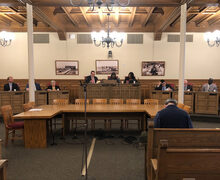Marcus Solis, a broadcast journalist, discusses state of news industry during lecture
Sarah Lee | Contributing Photographer
Solis has reported abroad in countries such as Mexico and Cuba, and was also one of the first reporters to cover the earthquake in Haiti in 2010.
Syracuse University alumnus and broadcast reporter Marcus Solis discussed the state of the news industry during a lecture on Tuesday night as part of the University Lectures series.
Solis has worked at WABC-TV, a news station in New York City, for more than 20 years. He graduated from the S.I. Newhouse School of Public Communications in 1991 with a degree in broadcast and digital journalism. More than 40 people attended the talk in Hendricks Chapel.
The focus of the discussion was the impact of digital disruption on today’s media. With social media platforms such as Instagram, Facebook and Twitter, reporters are expected to release information more immediately before relaying the longer form of their report, he said.
“It’s a real challenge. This push to digital that is happening,” Solis said. “It’s not as simple as moving our product onto a digital platform — you have to adapt.”
Local news and smaller media platforms have suffered at the hand of digital disruption, as some are unable to make the transition to digital-based content as easily as publications like The New York Times or The Washington Post, Solis said.
Monetization is especially difficult in this age of digital disruption. When WABC-TV — where Solis has worked for more than 20 years — posts a story to Facebook, they can’t obtain ad revenue, he said. The benefits of the ad revenue go directly to Facebook, he said. The station also has a YouTube channel, but it only makes $3,000 a month.
People no longer pay attention to their news sources when they see stories on social media, which Solis said is problematic. WABC-TV aims to maintain brand loyalty with their station and hopes people will turn to them for the full story after seeing bits of information spread online, he said.
With easy access to cellphones and social media, there’s been an increase in what Solis called citizen journalism. People are now personally documenting and sharing news events online, but not everyone has the same resources as professional journalists, he said. While there are benefits in having anyone be able to capture a story on a cellphone, that content cannot always be trusted, Solis said.
“It works both ways. We have more access to information and pictures, but at the same time it can lead to more disinformation,” Solis said.
The reason for the media’s perceived bias is the industry’s dedication to challenging authority and reporting on underdogs, which may be perceived as liberal viewpoints, Solis said. WABC-TV prides itself on remaining objective and going the extra mile to tell both sides of the story, he said.
Long before the current age of “fake news,” Solis said, there was always dislike and inherent resistance toward the press. He doesn’t engage with people who yell “fake news,” and sometimes he laughs it off.
Solis began his career at a radio station in White Plains, New York. He moved to Clarksburg, West Virginia, to work at a local TV station and later spent four years as an anchor reporter for NY1. Then, in 1997, he joined WABC-TV as a general assignment reporter.
Solis answered student questions about sustaining a lasting career in the journalism industry. Students should trust the process and value their work, he said.
“You work at it every day. Every day is a challenge to go out and do it better than the other guy,” he said. “And that will keep you around because you’re better than the other guy.”
Solis also stressed the importance of storytelling in reporting, especially the ability to synthesize information, separate the necessary from the irrelevant, and tell the story in an interesting way. Captivating audiences, he said, is especially important in the age of digital disruption.
He said the best and worst part of being a reporter is the same: It’s not a typical nine-to-five job. Reporters never know where they’re going or what stories they’re going to be covering, he said.
Fluent in Spanish, Solis has reported abroad in countries such as Mexico and Cuba. He was also one of the first reporters to cover the earthquake in Haiti in 2010. Getting out of his comfort zone when reporting abroad is a challenge, he said, because he doesn’t know the terrain.
While the future of media is uncertain, he said he still believes there will still be models of broadcast journalism, like WABC-TV.
“There’s a need for content, a need for providers, a need for people to tell stories. That’s what it comes down to,” Solis said.
Published on October 22, 2019 at 10:54 pm
Contact Sarah: scalessa@syr.edu | @sarahalessan





